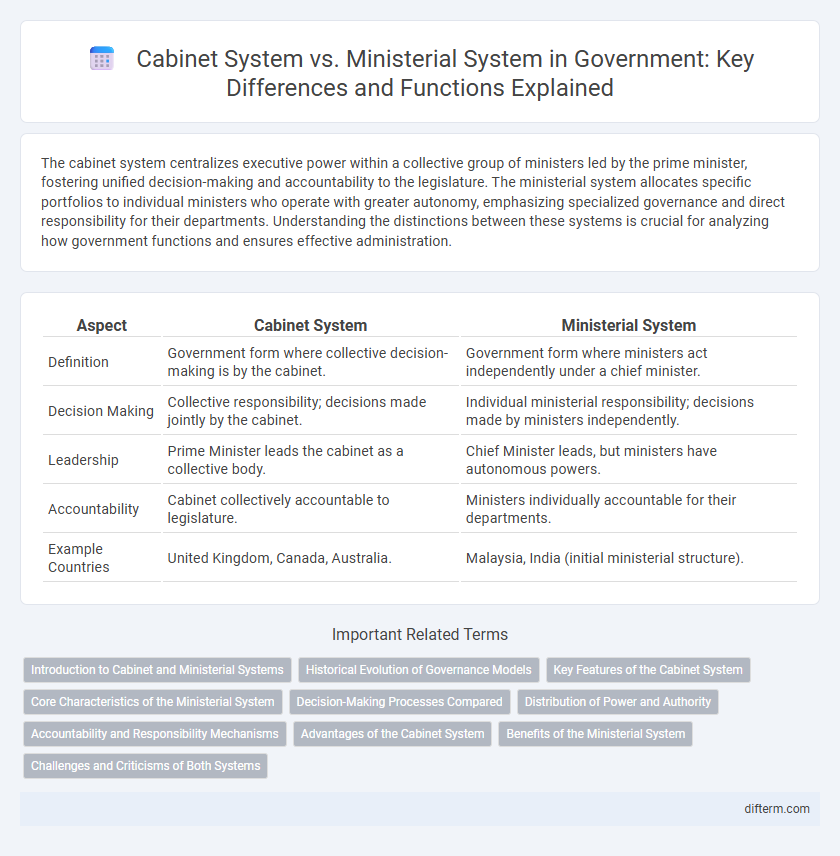The cabinet system centralizes executive power within a collective group of ministers led by the prime minister, fostering unified decision-making and accountability to the legislature. The ministerial system allocates specific portfolios to individual ministers who operate with greater autonomy, emphasizing specialized governance and direct responsibility for their departments. Understanding the distinctions between these systems is crucial for analyzing how government functions and ensures effective administration.
Table of Comparison
| Aspect | Cabinet System | Ministerial System |
|---|---|---|
| Definition | Government form where collective decision-making is by the cabinet. | Government form where ministers act independently under a chief minister. |
| Decision Making | Collective responsibility; decisions made jointly by the cabinet. | Individual ministerial responsibility; decisions made by ministers independently. |
| Leadership | Prime Minister leads the cabinet as a collective body. | Chief Minister leads, but ministers have autonomous powers. |
| Accountability | Cabinet collectively accountable to legislature. | Ministers individually accountable for their departments. |
| Example Countries | United Kingdom, Canada, Australia. | Malaysia, India (initial ministerial structure). |
Introduction to Cabinet and Ministerial Systems
The cabinet system is a form of government where executive powers are vested in a collective body called the cabinet, which is responsible for policy formulation and decision-making. The ministerial system, often practiced in parliamentary democracies, features individual ministers who head specific government departments and are accountable to the legislature. Both systems emphasize accountability and collective responsibility but differ in the distribution of powers between the cabinet as a whole and individual ministers.
Historical Evolution of Governance Models
The historical evolution of governance models reveals that the cabinet system originated in the United Kingdom during the 18th century as a mechanism to consolidate executive power within a collective decision-making body, replacing the earlier monarchical rule. In contrast, the ministerial system evolved in continental Europe, particularly in France and Germany, emphasizing individual ministerial responsibility to the legislature and fostering specialized departmental governance. These distinct developments reflect differing approaches to balancing authority and accountability within parliamentary democracies.
Key Features of the Cabinet System
The cabinet system features collective responsibility, where ministers are jointly accountable to the legislature for government policies and decisions. Decision-making is centralized within the cabinet, led by the prime minister, ensuring coordinated and unified governance. This system emphasizes confidentiality of cabinet discussions and promotes solidarity among ministers to maintain political stability.
Core Characteristics of the Ministerial System
The ministerial system centers on individual ministers heading their respective departments with clear accountability to the legislature, which ensures effective oversight and responsiveness. Unlike the cabinet system, it emphasizes distinct roles and responsibilities, allowing ministers to exercise autonomous decision-making within their portfolios. This system fosters specialization and direct communication between ministers and parliamentary bodies, enhancing transparency and policy implementation.
Decision-Making Processes Compared
The cabinet system centralizes decision-making within a collective body of ministers, promoting collaborative deliberation and joint responsibility for government policies. In contrast, the ministerial system assigns decision-making authority primarily to individual ministers, allowing for more specialized and autonomous control over specific departments. This distinction affects policy coherence and accountability, as the cabinet system encourages unified government action while the ministerial system may lead to more segmented and specialized governance.
Distribution of Power and Authority
The cabinet system centralizes power within a collective body of ministers who jointly make decisions, ensuring cohesion and accountability in governance. In contrast, the ministerial system disperses authority among individual ministers, granting them autonomy over their respective departments and enabling specialized administration. This fundamental difference affects policy coordination and the balance between collective responsibility and individual ministerial independence.
Accountability and Responsibility Mechanisms
The cabinet system centralizes accountability by requiring collective responsibility for decisions, ensuring ministers act as a unified body under the leadership of the prime minister. In contrast, the ministerial system emphasizes individual ministerial responsibility, where each minister is directly accountable for their department's actions and policies. Both systems aim to maintain transparency and control, but the cabinet system fosters joint accountability, while the ministerial system highlights personal responsibility.
Advantages of the Cabinet System
The cabinet system enhances collective decision-making by ensuring that all ministers share responsibility for policies, promoting unity and coherence within the government. It allows for greater accountability as the cabinet as a whole is accountable to the legislature, enabling more effective checks and balances. This system fosters coordinated policy implementation by enabling close collaboration among ministers, resulting in streamlined governance and consistent administrative actions.
Benefits of the Ministerial System
The ministerial system fosters greater accountability by assigning clear responsibilities to individual ministers who oversee specific departments, enhancing transparency in governance. It promotes specialization and expertise as ministers are selected based on their knowledge and experience in particular sectors, leading to more effective policy-making and administration. This system also encourages collective decision-making within the cabinet, ensuring balanced and well-informed government actions.
Challenges and Criticisms of Both Systems
The cabinet system faces challenges such as potential dominance by a single party, leading to limited representation and weakened checks and balances, while the ministerial system often struggles with fragmented authority and coordination issues among ministers. Both systems are criticized for inefficiencies in decision-making, with the cabinet system sometimes criticized for excessive centralization and the ministerial system for lack of cohesive policy direction. These challenges hinder effective governance, accountability, and responsiveness to public needs in both frameworks.
cabinet system vs ministerial system Infographic

 difterm.com
difterm.com